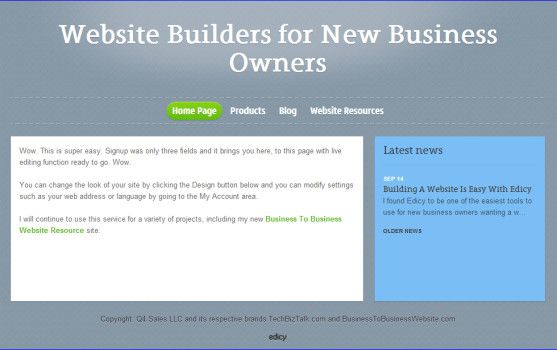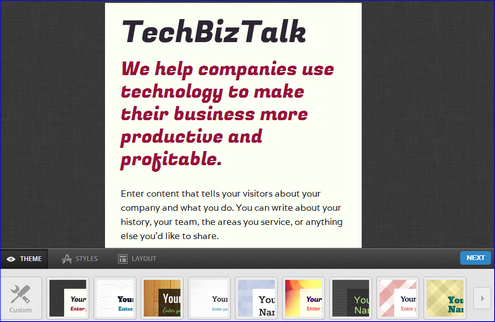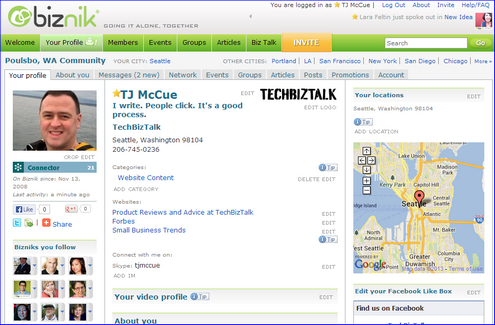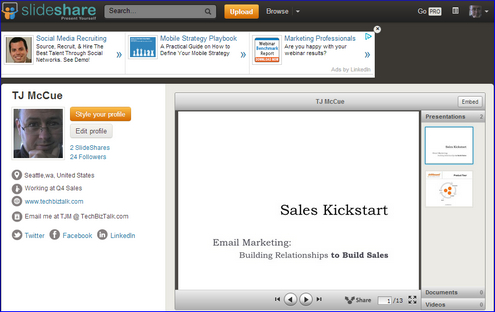How do I start and build a website? This is one of the more commonly searched questions by small business owners. Thanks to Google and various government statistics we know that about 50 percent of businesses do not have a website. I find this astounding. When it is such an easy thing to do, why isn’t that number closer to 100 percent? If you have been looking for how to build a free or low-cost website, this post is for you.
Some of the more popular ones I profiled here in 2010: DoodleKit, ezWeb123, Google Sites, Jimdo, Wix, and Weebly, to name just a few. Since that time, I have been studying the topic, partly because I used to build websites for new businesses and also because I review technology tools to help you stay productive and profitable. Earlier this year I finished my first book (which I will email you for free): Website Design You Can Do Yourself: 30+ Free and Affordable Tools To Build and Market Your Own Website. This post is drawn from this new book.
20 Plus Ways to Build a Website or Web Presence
About.me is a very simple Web page option for small business owners. You can look at it as a “landing page” about you. I would almost venture to say that it is the resume of the future. It allows you to pull in all of your social network streams, your blog, and whatever contact information you want to share. Free.
Doomby is a solid choice for a new business owner building a website. After filling in a form, you can save and activate your website immediately. Once you land in the dashboard, they wisely ask you where you want to go next, which is quite helpful for newcomers. Free service with option to upgrade to paid plan.
Edicy is quite possibly the fastest and most elegant website builder I’ve used. It is mind-boggling, frankly. Easy sign up process, then you jump right into the site building dashboard. The site I built in a matter of moments is in the screenshot above. While it is nothing fancy, I base part of my review on can it be done without much effort. This service can work for just about anyone, but it looks terrific small businesses that desire an international presence because it offers multilingual capabilities. They offer a light free plan, then standard service is approximately USD $8/month and the “Plus” level is USD $13/month.
IM-Creator has a short learning curve among website builders. The drag-and-drop interface is refreshing, and with one click, you add a photo gallery and with another click, delete it. The same is done for adding a new text element or an entire page or a YouTube video. You overcome the short learning curve by simply testing how the different elements work. You can create a free site or upgrade for $7.95/month on a 12-month contract.
Jimdo has a unique option that allows you to build an actual online store, not just a website. You can list up to five items for free. It comes with free search engine optimization and other great features like RSS feed, but not free e-mail. Pick a subdomain name for your free site and enter your email and you’re ready to start customizing your free Jimdo site.
Lifeyo is a website builder that uses the powerful Amazon.com backend to host your website. Their drag-and-drop options really work well. They do not require a credit card to sign up, but the trial period is less than a month long. The plans vary in price from $8 – $25 per month but offer annual and biannual discounts.
OnePager is built on the premise that you might only need a one-page website. More than that, they believe that fast signup means you don’t even sign up. You do not have to enter any info to start building (see screenshot above). You simply click “Start building” and you are customizing your site. They certainly allow you to add more pages, but they recognize that many, if not most, small businesses can succeed with a very simple website. In addition, they have loads of options to make your site more powerful for only $8/month.
Puzl is a relatively new free website design tool that is advertising-supported. I found it to be quite elegant and user-friendly. Even after I published the test site, I didn’t find any advertising in the traditional sense. There was a footer link that said the site is built by Puzl.com, but that was all. I think that’s a fair trade-off for a free website, especially one that looks good and is simple to set up. They do charge if you have an existing domain and choose to map your domain to your free site.
Squarespace looks like the Apple of website builders. The templates offer interesting alternatives that have specific types of businesses in mind. I should restate this: Their templates explode off the page. Take a look at this sample I created in less than 5 minutes: Squarespace Sample by TJ. Their lowest cost plan runs $10 per month (or $8/mo if you prepay annually) and has healthy space and bandwidth.
vFlyer is a combination of website builder, Craigslist ad service, and single page web builder. The flyers you create can be posted, added to your website as pages, or even emailed to a mailing list. You can even turn the flyers into a printable PDF. If you manage online classified type ads to grow your business, you will like this service. Plans start at $12/month with a discount on annual subscription. 14-day free trial.
Yola offers a very easy process with just four fields to get started. The service then walks you through various options and templates to get your free site going. There were many professional templates to choose from and Yola made it easy to change templates before clicking the “Publish” button. They have a free plan, then paid plans start at $4.95/month.
What If You Just Do Not Have Time to Build a Website?
Even with the ease of these tools, there is still a learning curve. For some business owners, these tools just do not cut it. While I firmly believe that having a website is essential for business, it is not my job to persuade you but to give ideas to help you keep moving forward. With that in mind, I offer you these well-known and lesser-known options for maintaining a web presence.
Email Marketing Packages with Add-on Archive: Many small businesses use email newsletters to keep in touch with customers, but don’t have a website yet (surprising I know). Depending on your business, as noted in the introduction, you might be able to stay thrifty and leverage the “Email Archive” service that many email providers offer. For example, for an additional $5/month, Constant Contact will allow you to turn your emails into a Web page and archive them, with a link, for customers and prospects to access. The archives are often found by search engines if you make them publicly available.
Biznik: This is a social network focusing on small business owners. Member profiles are frequently found at the top of a Google search for keywords related to your profession (presuming you’ve built your profile correctly, and the service team will help you).
Facebook Business Page: Many use a Facebook Business page in combination with some other marketing campaign, but interacting with your friends, family, and potential customers is valuable if your service is consumer-oriented. There are business-to-business companies there, too, but the results I hear about are mixed. The Business Page options allow you to add a lot of information about your company and maintain a blog, of sorts, right within Facebook. Again, it is well worth it to have your own website. Otherwise, as Anita Campbell, CEO of Small Business Trends, puts it – you are just a digital sharecropper camping out on someone else’s site, beholden to their rules and regulations.
LinkedIn used to be mainly for job seekers and people networking for that next big job, but they’ve added robust options for companies to showcase their work. The LinkedIn Company Page is a terrific way to keep in touch with prospects and customers and network for more.
Google Places – This is tied to your Google account and your location. You don’t have to have a business storefront, but you need a real address. It allows you to post details about your services, offer coupons, post photos, your important contact information, all for free. There are still reasons to use this even if you have a Google Site.
Flickr – Many photographers and creative types use Flickr more than a website in many cases. It provides a way to store tons of photographs and display your work. Your profile information is easily accessible by those viewing your photos. With the latest Yahoo! announcement, you get one terabyte of free storage. That is a lot of storage.
SlideShare.net – This service is ideal if you are a solo sales-oriented businesses (say a self-employed trade rep or a buyer for a range of companies) and you survive making presentations. For $19/month, SlideShare gives you custom branding and a profile area as well as storage for your presentations. You can track customer visits. They have a free account, but you can’t customize it. If you simply need a web location and don’t want a lot of the stuff that goes along with keeping up a website, this option might work for you. It is quite robust and can work as a powerful lead management system.
Yelp and Angie’s List – these customer review sites are a huge opportunity. There is a fair amount of contention around whether these services are good for business or not, but they are not going away. With the right attitude and approach, you can grow your business with Yelp and others. Each of these services allows you to have a detailed profile and gives you tools to track visits and reviews. You could survive without a website if you used one or both of these services wisely.
Evernote – Millions of people are rabid about this wonderful online notebook, but did you know you can make your notebook public to non-Evernote users, too? You can by simply right-clicking on a notebook and selecting “share” and you’ll get a link like to share. It won’t be a beautiful custom-domain type link, but you could shorten it at Bit.ly and provide samples to your writing or other work this way. The free account is loaded with storage space.
There you have it: 20+ ideas to build a website or web presence.
Again, these are not the be-all, end-all of website options. As I have said many times, there are no rules here. You can do any or many of these and still succeed. There are tons of great website designers and programmers who can build something custom for you, if that’s what you prefer. The goal of this post is to help you get a presence started: Something fast and affordable.







